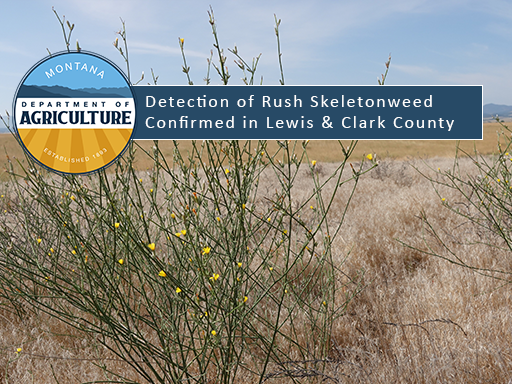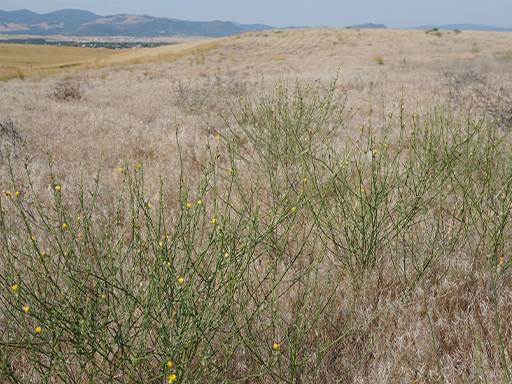Detection of Rush Skeletonweed Confirmed in Lewis & Clark County

CONTACT:
Logan Kruse, Montana Department of Agriculture, (406) 444-3684
Joshua Wagoner, Montana Department of Agriculture, (406) 444-7880
Detection of Rush Skeletonweed Confirmed in Lewis & Clark County
HELENA, Mont. – The Montana Department of Agriculture (MDA) confirmed Rush Skeletonweed at two different sites outside of Helena, Montana. Rush Skeletonweed (Chondrilla juncea), a Montana Priority 1B Noxious Weed, has limited presence in Montana and if found requires eradication or containment and education.
This is currently the only population of Rush Skeletonweed east of the Continental Divide in the state. The invasive weed can reduce crop yields by as much as 70 percent once established, which is why establishment prevention in central and eastern Montana is critical.

Rush Skeletonweed pictured in Lewis & Clark County
Rush Skeletonweed is branched with few or no leaves, giving it a “skeleton-like” appearance. The rosettes look identical to dandelions and once bolted, the stems have stiff downward pointing hairs at the base. Flowers are yellow, smaller than a dime, appear in late summer, and when seeded, have tufted white hairs that disperse in the wind. All plant parts exude a milky latex when broken. Rush Skeletonweed can invade rangeland, farmland, roadsides and even neighborhood yards. It can easily be confused with tumble mustard (Sisymbrium altissimum), which has small four-petaled pale yellow flowers, and the native rush skeleton-plant (Lygodesmia juncea), which has no hairs at the stem base, does not contain milky sap, and has pinkish flowers.
Rush Skeletonweed is difficult to control and harmful to both agriculture and wildland habitat. There are currently 6.2 million acres of Rush Skeletonweed in the western United States, including 4 million acres in Idaho. While Montana currently only has around 3,300 acres, it is critical to keep it from spreading and to eradicate new infestations when found. To report a suspected Rush Skeletonweed plant, submit a report on EDDMapS and contact your local county weed coordinator or the Montana Department of Agriculture Noxious Weed EDRR Program at MTEDRR@mt.gov. For additional resources and contact information, visit the Early Detection, Rapid Response webpage here: agr.mt.gov/Noxious-Weeds.
The Montana Department of Agriculture is serving Montana Agriculture and growing prosperity under the Big Sky. For more information on department programs and services, visit agr.mt.gov.
###
Tags: Noxious Weeds and EDRR
